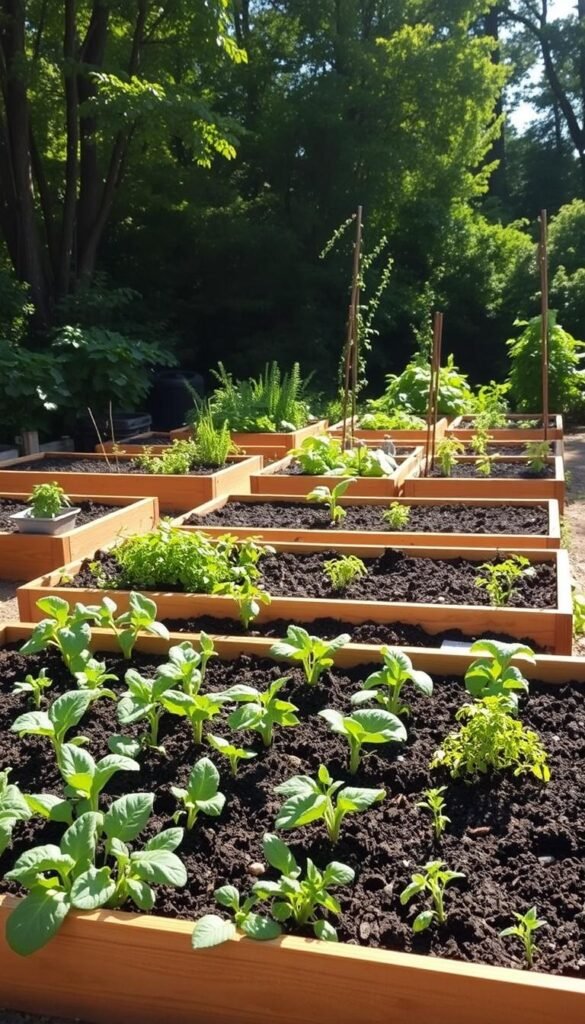Imagine stepping into your backyard to pick fresh tomatoes, crisp lettuce, and fragrant herbs – all from a single organized growing area. A thoughtfully designed 32-square-foot plot gives you room to grow diverse crops while keeping maintenance simple. This approach combines space efficiency with smart growing techniques, making it ideal for both new and experienced growers.
Why has this specific setup become a favorite? The rectangular shape allows easy access from all sides, eliminating the need to step on soil. You’ll find it simpler to rotate crops, pair complementary plants, and stagger harvests for continuous yields. Whether you’re growing juicy peppers or leafy greens, every inch works harder for you.
One major advantage lies in material efficiency. Building this structure requires minimal lumber, and our guide on how to build a raised bed shows just how affordable it can be. The height also reduces strain on your back – no more bending over for hours to tend your plants.
Throughout this guide, you’ll discover how to:
- Pair vegetables that boost each other’s growth
- Plan seasonal rotations for year-round harvests
- Use vertical space for climbing plants like beans
Get ready to transform your outdoor space into a productive and enjoyable growing zone that keeps your kitchen stocked with homegrown goodness.
Understanding the Value of Raised Garden Beds
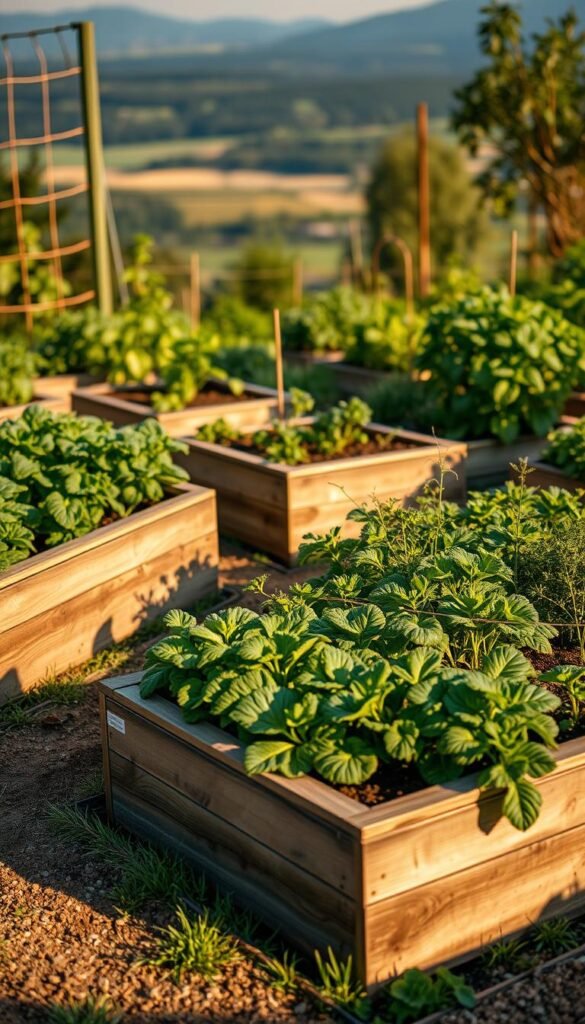
Ever struggled with stubborn clay soil or watched slugs devour your seedlings overnight? Modern growing solutions tackle these frustrations head-on. Unlike ground-level plots, elevated systems give you control over your growing environment while working smarter, not harder.
Key Benefits of a 4×8 Setup
Durable Zn-Al-Mg steel frames resist rust and last decades, saving replacement costs. The open-bottom design lets excess water drain freely – no more soggy roots during rainy springs. You’ll notice fewer snails crawling up the sides compared to traditional plots.
Ergonomic height means less bending during planting or weeding. Your soil warms faster in early spring, letting you start crops weeks earlier. Plus, contained spaces make it easier to rotate tomatoes and leafy greens yearly without nutrient depletion.
Comparing Raised Beds with Traditional Gardens
Ground-level gardens often battle compacted earth and poor drainage. Elevated systems let you customize soil blends for each crop’s needs. Pests like ants struggle to reach plants, cutting pesticide use by up to 40% in some cases.
Maintenance becomes simpler too. Narrow dimensions let you reach every plant without stepping on soil. You’ll spend less time weeding and more time harvesting – a clear win for busy growers.
Planning Your 4×8 Raised Bed Garden Layout: Efficient Planting Plans for Popular Veggies
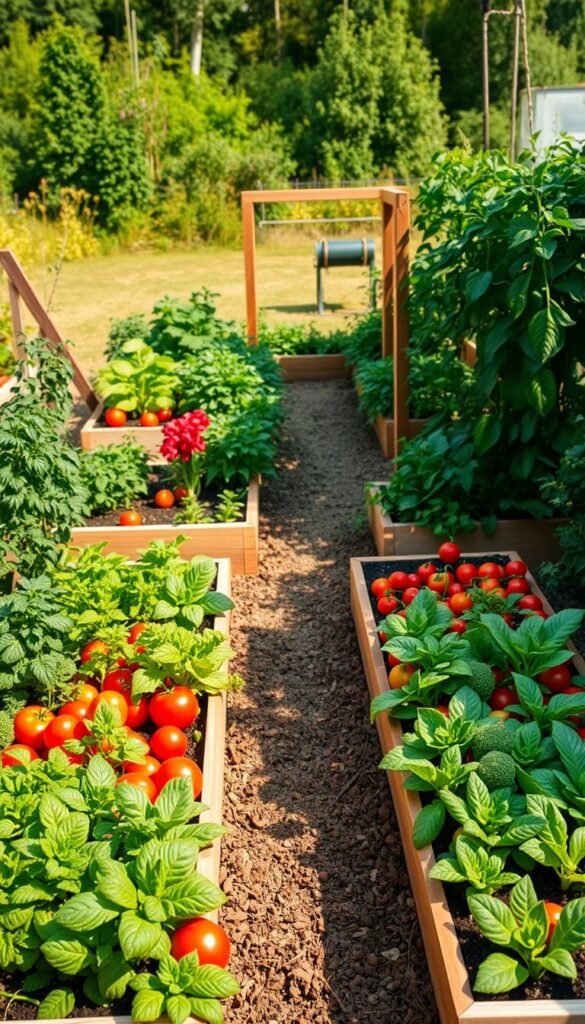
Have you ever mapped out your growing space to maximize every ray of sunshine? Start by observing how light moves across your yard. Most vegetables thrive with 6-8 hours of direct sunlight, so track patterns over a few days. Use a sun calculator app or mark shadows hourly to identify prime spots.
Assessing Your Garden Space and Sunlight Needs
South-facing areas typically get the most light, perfect for tomatoes and peppers. If trees or buildings create shade, try reflective mulch or light-colored surfaces to bounce sunlight onto plants. For spaces with under 4 hours of sun, grow leafy greens like spinach—they’ll appreciate the cooler conditions.
Wind exposure matters too. Position taller crops like corn on the windy side to protect delicate plants. Always ensure water sources sit within hose reach—you’ll thank yourself during dry spells.
Determining Bed Dimensions and Placement
Stick to a 4-foot maximum width for easy access from both sides. Depth options range from 6 inches for shallow-rooted herbs to 2 feet for deep feeders like carrots. An 8-foot length fits standard lumber sizes, reducing construction waste.
Leave 18-24 inches between beds for comfortable kneeling and wheelbarrow access. Elevate the structure slightly if your yard has drainage issues—just 2 inches of slope prevents waterlogging. Remember: good airflow between plants reduces disease risks.
Seasonal Planting Strategies for a Bountiful Harvest
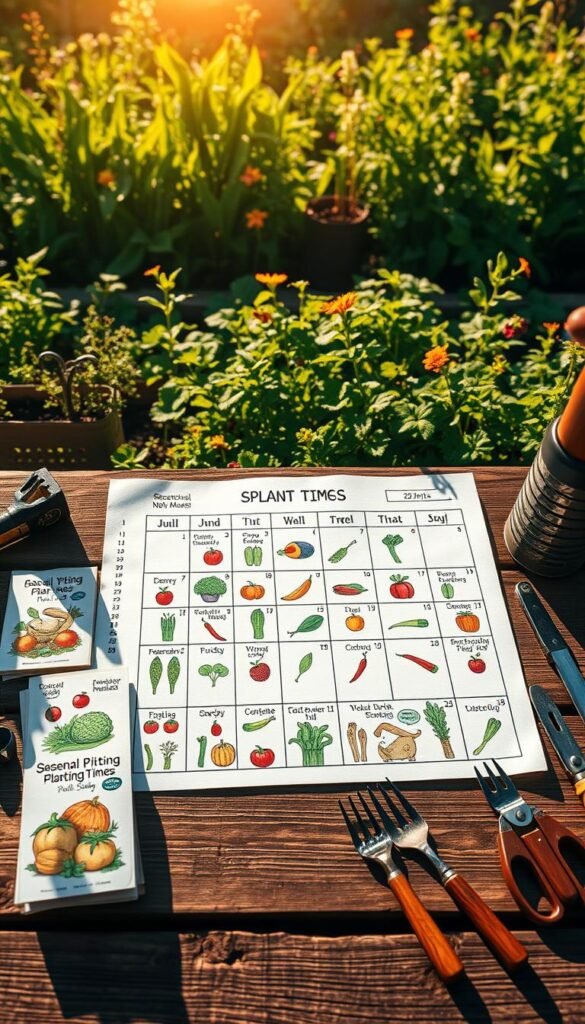
What if your garden could produce fresh meals from spring through fall? Timing your plantings and rotating crops lets you squeeze maximum value from every square foot. Let’s explore how to align your efforts with nature’s calendar.
Spring Planting: Cool Crops and Soil Preparation
Kick off the growing season with cold-hardy favorites. Leafy greens like spinach and lettuce thrive when temperatures hover between 50-70°F. Pair them with root vegetables like radishes and carrots for a diverse early harvest.
Enrich your soil with 2-3 inches of compost before sowing seeds. This boosts nutrients and improves drainage. After harvesting quick-growing radishes in late spring, replant those spaces with heat-loving basil or bush beans.
Summer Adaptations: Warm Crops and Water Management
When soil warms above 60°F, transition to sun-worshipping plants. Tomatoes and peppers become your garden stars. Surround them with marigolds – their pungent scent naturally deters pests.
Mulch heavily with straw to lock in moisture during heatwaves. Water deeply 2-3 times weekly, focusing on the base of plants. A balanced organic fertilizer every 4 weeks keeps crops productive through August.
Fall Transitions: Row Covers and Succession Planting
As days shorten, replant cool-weather champions like kale and Swiss chard. These hardy greens tolerate light frosts and even taste sweeter after a chill.
Use floating row covers when temperatures dip below 32°F. This lightweight fabric adds 4-8°F of protection, letting you harvest Brussels sprouts into December. Plant garlic cloves in October for next summer’s bulb harvest.
Essential Tools and Materials for Building Your Raised Garden Bed
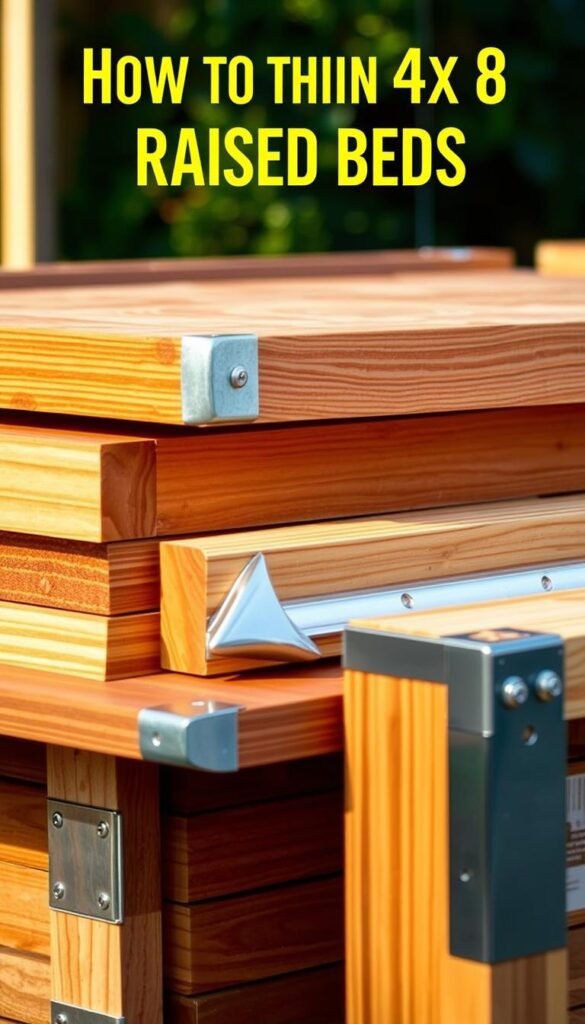
The secret to a long-lasting garden lies in the materials you choose. Safe construction starts with untreated wood or food-grade metals that won’t contaminate your crops. Did you know some pressure-treated lumber contains arsenic? That’s why selecting non-toxic options matters for growing edibles.
Choosing the Right Materials and Accessories
Opt for rot-resistant cedar or galvanized steel frames. These stand up to weather while keeping chemicals out of your soil. Here’s a quick comparison of popular options:
| Material | Cost | Lifespan | Safety |
|---|---|---|---|
| Cedar | $$ | 10–15 years | Non-toxic |
| Pine | $ | 5–7 years | Requires sealing |
| Composite | $$$ | 20+ years | Check for VOC-free |
| Galvanized Steel | $$$$ | 25+ years | Food-grade coating |
For deep beds, try the hugelkultur method. Layer sticks and leaves at the base, then top with compost. This natural filler improves drainage and feeds plants for years. One gardener shared:
“My carrot harvest doubled after switching to layered organic materials.”
Step-by-Step Construction Tips
Gather these essentials: a drill, level, gloves, and galvanized screws. Assemble frames on a flat surface, checking corners with a carpenter’s square. Line the bottom with hardware cloth to block burrowing pests—those sneaky voles won’t stand a chance!
Fill your structure using the 50/30/20 rule: 50% topsoil, 30% compost, and 20% perlite for aeration. This mix creates the perfect home for roots while reducing waterlogging. Remember to wear gloves when handling sharp edges on wire mesh!
Innovative Layout Techniques and Companion Planting
What if your garden could yield more with less effort through smart design? By combining space-saving methods with natural plant partnerships, you create a thriving ecosystem where crops support each other’s growth. Let’s explore two powerful strategies that turn your growing area into a high-performance food factory.
Maximizing Space with Square-Foot Gardening
This method transforms your growing area into a grid of 1-foot squares. Each section hosts a specific plant quantity based on its size. Leafy greens like spinach fit 9 per square, while larger tomatoes need one per section. Our guide to square-foot garden plans shows how to arrange 32 squares for continuous harvests.
| Method | Plants per 4×8 Bed | Weeding Time | Harvest Frequency |
|---|---|---|---|
| Traditional Rows | 60-80 | 3 hrs/week | Single crop |
| Square-Foot Grid | 120-160 | 1 hr/week | Multiple cycles |
Companion Planting to Enhance Crop Health
Strategic pairings create natural pest control and nutrient sharing. Basil releases oils that mask tomatoes from hornworms, while onions deter carrot flies with their strong scent. Try these winning combinations:
- Leafy greens + radishes (quick harvest clears space)
- Strawberries + spinach (shade protection + ground cover)
- Beans + corn (natural trellis + nitrogen fixation)
Mix deep-rooted carrots with shallow lettuce to prevent root competition. Marigolds along bed edges repel nematodes while attracting pollinators. One gardener noted: “My vegetable garden became pest-resistant after adding aromatic herbs between crops.”
Optimizing Soil Health, Watering, and Pest Management
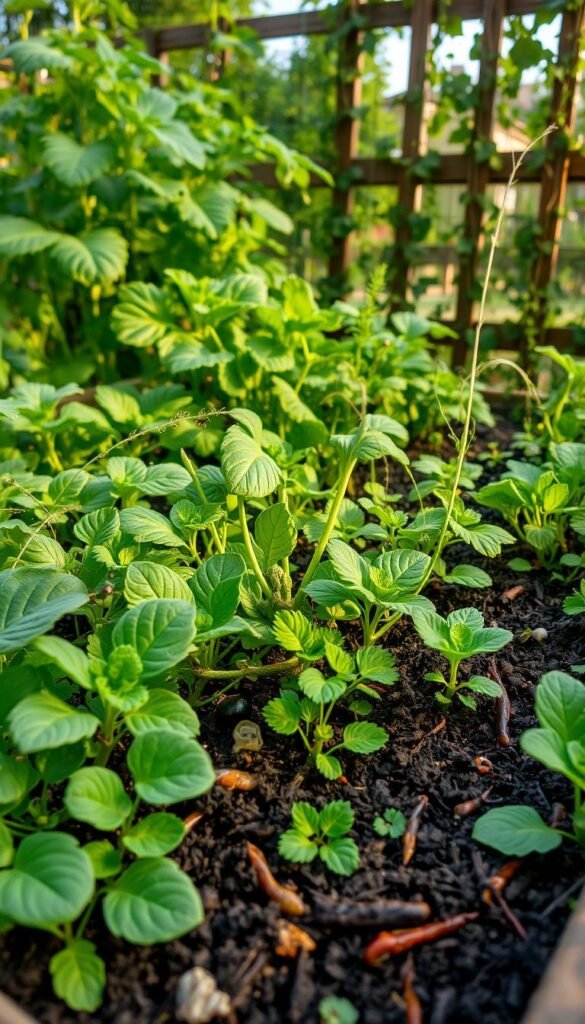
Did you know your garden’s success starts beneath the surface? Thriving plants need balanced nutrition and protection from unwanted visitors. Let’s explore how to create ideal conditions while keeping your bed vegetable garden chemical-free.
Soil Amendments, Compost, and Drainage Benefits
Too much compost can backfire. Root vegetables like carrots need loose, moderately fertile soil – aim for a 1:3 compost-to-topsoil ratio. Test your mix annually with a $10 kit from garden centers. One grower shared: “My radishes stopped splitting when I reduced compost levels.”
Proper drainage prevents root rot. Mix perlite into heavy soils and slope beds slightly. Water deeply 2-3 times weekly rather than daily sprinkles – this encourages stronger root systems.
Effective Pest Control and Natural Remedies
Invite nature’s pest controllers. Plant marigolds to lure ladybugs that devour aphids. Crushed eggshells deter slugs without chemicals. For stubborn cabbage worms, try this spray:
- 1 garlic bulb (minced)
- 1 tsp cayenne pepper
- 1 quart water
Spray leaves weekly, focusing on undersides where pests hide. Companion planting with mint or basil adds extra protection. Remember: healthy plants resist infestations better than stressed ones!
Creative Garden Designs: Vertical and Border Planting Ideas
What if you could grow twice as much without expanding your garden area? By thinking upward and outward, you unlock hidden potential in your growing space. Vertical structures and strategic border arrangements let you harvest more while keeping everything within arm’s reach.
Integrating Vertical Elements for Extra Space
Trellises turn empty air into productive real estate. Climbing varieties like cucumbers and pole beans thrive when given upward support. A simple A-frame structure made from bamboo or metal mesh can hold 20+ pounds of produce while saving ground space for herbs or leafy greens.
Choose sturdy supports for heavy growers like indeterminate tomatoes. Cattle panels or welded wire grids withstand summer storms and won’t topple under ripe fruit. One gardener shared: “My tomato yield tripled after switching from wooden stakes to steel trellises.”
| Crop | Support Type | Space Saved |
|---|---|---|
| Snow peas | Netting | 75% |
| Winter squash | Arbors | 90% |
| Gourds | Fence panels | 85% |
Border planting transforms unused edges into productive zones. Tuck compact herbs like thyme along bed perimeters where they’ll get full sun. Tall flowers like sunflowers make natural windbreaks while attracting pollinators to your garden beds.
Arrange plants by height – place climbing varieties at the north side to avoid shading shorter crops. This approach keeps mint contained and lets trailing nasturtiums spill over bed edges beautifully. You’ll create visual interest while maximizing every inch of your growing area.
Bringing It All Together: Crafting Your Personalized Garden Blueprint
Your dream harvest begins with a pencil and paper. Sketch your vegetable garden layout around sunlight patterns and plant heights. Taller crops like tomatoes belong on the north side, while low-growing herbs thrive along southern edges. This simple planning step prevents shading issues and boosts yields.
Mix leafy greens with root vegetables to maximize soil layers. Pair onions with carrots – their scents naturally repel pests. Leave breathing room between rows for airflow and easy harvesting. Vertical trellises for cucumbers or peas free up ground space for heat-loving peppers.
Consider staggered planting dates. Sow quick-growing radishes between slower cabbage plants. When you pull the radishes, the cabbage gains room to expand. Rotate crops yearly to keep soil nutrients balanced and diseases at bay.
Remember: your garden layout evolves with experience. Start small, track what thrives, and adjust next season. With smart planning, even compact beds become abundant sources of fresh flavors. Now grab those seeds – your kitchen’s about to get a tasty upgrade!

